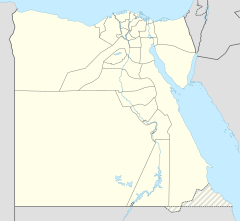|
Juyushi Mosque
The Juyushi Mosque (Arabic: الجامع الجيوشى, lit. 'Mosque of the Armies') is a historic monument in Cairo, Egypt. The mosque is dated to 1085 CE, during reign of the Fatimid Imam-Caliph al-Mustansir Billah. Its construction was sponsored by Badr al-Jamali, the vizier of al-Mustansir, who was Amir al-Juyush (Arabic: امير الجيوش, lit. 'Commander of the Armies'). It is located on the Muqattam hills above the Southern Cemetery of Cairo.[1] Historical backgroundThe building's construction is dated by an Arabic foundation inscription to 1085, during the Fatimid period and the reign of al-Mustansir Billah. The inscription identifies the structure as a mashhad (Arabic: مشهد, lit. 'shrine'), meaning a commemorative shrine or mausoleum.[2][3] It is not clear whom the mashhad commemorates or what its exact function was.[4][1] The most plausible theory is that the monument commemorates the victories of Badr al-Jamali, the powerful Fatimid vizier whose title, Amir al-Juyush ("Commander of the Armies"), is invoked in the foundation inscription.[5] Badr al-Jamali himself was not buried here, but rather in a tomb outside Bab al-Nasr, according to al-Maqrizi.[2] The structure's isolated setting on the Muqattam hills above Cairo is also unusual and has even led to one scholarly theory suggesting it was actually a watchtower disguised as a mosque.[2][1][4] In 1731–2, during the Ottoman period, the building was restored and some painted decoration was added to the interior.[5] In the 1990s the mosque underwent a major renovation organized and funded by the Dawoodi Bohra community, who restored several other Fatimid-era mosques in Cairo around this time.[1][6] Some historical details, including Ottoman decoration, were eliminated during the restoration.[5][1] As of 2018, the mosque was situated inside a military zone and was not open to visitors without special permission.[1] ArchitectureGeneral The building, often described as a mosque, is the most complete mashhad (commemorative shrine) to survive from the Fatimid period.[2] It is centered around a small courtyard, which is entered from the outside through a plain door and passage. On one side of the courtyard is the prayer hall or sanctuary, while opposite this, standing on the central axis of the building, is a minaret. On the other two sides of the courtyard are rooms, as well as a passage leading to a small domed room projecting from the rest of the building. Small rooms also flank the minaret.[2] The prayer hall is entered from the courtyard via a large keel arch flanked by two smaller arches with supporting columns, an arrangement that recurs in Fatimid architecture.[2] Beyond this is a rectangular space covered by cross-vaults, followed by a roughly square area covered by a dome, flanked by two more spaces each covered by a cross-vault. The dome rests on an octagonal base with four plain squinches.[2] The mihrab (niche symbolizing the qibla) is covered in elaborate stucco decoration.[2] The conch or semi-dome section of the mihrab once contained 18th-century painted decoration from the Ottoman period,[2] but this decoration was destroyed during the modern Bohra restoration.[5] Stucco decoration also exists in the form of a medallion inscription at the summit of the dome and an inscription band along around the top of the chamber below the dome.[2] The minaret has a similar design to that of the Great Mosque of Kairouan[2] and it is also the earliest example in Egypt of a minaret with multiple tiers of different designs.[5] It is composed of a large rectangular (or cuboid) section, above which is a smaller square section that is topped by a dome with the same profile as the semi-dome of the mihrab.[2] Along the top of the minaret's first rectangular portion is a cornice of muqarnas (stalactite-like sculpting) which is the earliest surviving example of this type of decoration in Egypt.[2] InscriptionsOver the entrance there is an inscription which begins with Quranic verses 72:18 and 9:108. The English translation reads as follows:[3]
The inscription further continues:[3]
The mihrab is decorated with an inscription of Qur'anic verses the begins outside the mihrab niche and finishes inside it. The first verse is 24:11, followed by 24:36 and the beginning of 24:37, and finishing with verse 10:23 inside the mihrab. The English translation goes:[3]
Around the dome's base is an inscription inscribed verses 48:1-5:[3]
 At the summit of the dome is a carved medallion with a six-pointed star formed by the words Muhammad and Ali each repeated three times. Around the star is inscribed verse 35:39:[3]
See also
References
External links
|
||||||||||||||||||||||||||||||||||||
Portal di Ensiklopedia Dunia




